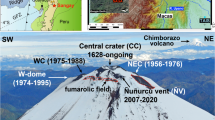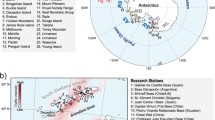Abstract
Active volcanoes are a regular occurrence in nature and are well known for the risk and devastation they cause when they erupt. In India, Barren Island volcano (BIV) has started erupting actively after the great earthquake (9.3 magnitude) and tsunami. In the current study, we present a satellite based approach to monitor the volcano dynamics at BIV using multispectral data sets along with volcanic radiative power (VRP) and field evidence for three various eruptive phases, i.e. 2005, 2015 and 2021. The results of VRP clearly depicts the changes from low to high thermal regimes that indicate switching from open vent to active activity of Barren Island volcano. In addition, HYSPLIT and ash modelling also shows that the ash transport pathways that flow in lower atmosphere travel over the neighbouring countries and also within Indian states. Further, we also conducted a field visit in 2021 November to validate the lab observations and geophysical studies. The current study has provided significant information regarding the location of primary, secondary vents, and ash transport pathways. Further it is inferred that, for a comprehensive risk assessment of the region, volcanism, environmental and coastal dynamics along with crustal deformation need to be considered.















Similar content being viewed by others
References
Bhattacharya, A., Reddy, C. S. S., & Srivastav, S. K. (1993). Remote sensing for active volcano monitoring in Barren Island India. Photogrammetric Engineering and Remote Sensing, 59(8), 1293–1297.
Blackett, M. (2014). Early analysis of landsat-8 thermal infrared sensor imagery of volcanic activity. Remote Sensing, 6, 2282–2295. https://doi.org/10.3390/rs6032282.
Campion, R. (2014). New lava lake at Nyamuragira volcano revealed by combined ASTER and OMI SO2 measurements. Geophysical Research Letters, 41(21), 7485–7492. https://doi.org/10.1002/2014GL061808.
Chandrasekharam, D., Vaselli, O., Capaccioni, B., Manetti, P., & Alam, M. A. (2003). Cold springs of the Barren Island, Andaman Sea, Indian Ocean. Current Science, 85, 136–137.
Coppola, D. (2020). Thermal remote sensing for global volcano monitoring: Experiences from the MIROVA system. Frontiers in Earth Science, 7, 362. https://doi.org/10.3389/feart.2019.00362.
Coppola, D., & Cigolini, C. (2013). Thermal regimes and effusive trends at Nyamuragira volcano (DRC) from MODIS infrared data. Bulletin Volcanolano., 75, 1–15. https://doi.org/10.1007/s00445-013-0744-z.
Coppola, D., Laiolo, M., Cigolini, C., Donne, D. D., & Ripepe, M. (2015). Enhanced volcanic hot-spot detection using MODIS IR data: Results from the MIROVA system. Geological Society, London, Special Publications, 426(1), 181–205. https://doi.org/10.1144/sp426.5.
Coppola, D., Laiolo M., Cigolini, C., Delle Donne, D. and Ripepe, M. (2016), J. Geol. Soc. London, Spec. Publ., 426(1), 181–205.
Curray, J. R. (2005). Tectonics and history of Andaman Sea region. Journal of Asian Earth Science, 25(1), 187–232. https://doi.org/10.1016/j.jseaes.2004.09.001.
Francesco, M., Genzano, N., Neri, M., Falconieri, A., Giuseppe, M., & Pergola, N. (2019). A multi-channel algorithm for mapping volcanic thermal anomalies by means of Sentinel-2 MSI and landsat-8 OLI data. Remote Sensing, 11(23), 2876. https://doi.org/10.3390/rs11232876.
Gunda, G. K. T., Champatiray, P. K., Mamta, C., Prakash, C., & Balaji, S. (2021a). Barren Island volcanism and seismicity: An intriguing finding. Journal of Earth System Science, 130, 162. https://doi.org/10.1007/s12040-021-01624-z.
Gunda, G. K. T., Champatiray, P. K., Mamta, C., PrakashMijanur, C. A., Arya, A., Yateesh, K., & Balaji, S. (2021b). Modelling of volcanic ash with HYSPLIT and satellite observations: A case study of the 2018 Barren Island volcano eruption event. Andaman Territory. Current Science, 121(4), 529. https://doi.org/10.18520/cs/v121/i4/529-538.
Gunda, G. K. T., Sridhar, A., Chauhan, M., Ansary, M., Chauhan, P., Sudhakar Goud, R., UdayaLaxmi, G., & Balaji, S. (2022). Barren Island Volcano: Recent field findings. Current Science., 123(02), 0143–0144.
Harris, A. J. L. (2013). Thermal remote sensing of active volcanoes: A User’s Manual (p. 736p). Cambridge University Press.
Kamesh Raju, K. A., Ramprasad, T., Rao, P. S., Rao, B. R., & Varghese, J. (2004). New insights into the tectonic evolution of the Andamanbasin, northeast Indian Ocean. Earth and Planetary Science Letters, 221, 145–162. https://doi.org/10.1016/S0012-821X(04)00075-5.
Martha Tapas, R., Priyomvinod, K., & Kumranchat, K. (2018). Lava flows and cinder cones at Barren Island volcano, India (2005–2017): A spatio-temporal analysis using satellite images. Bulletin of Volcanology, 80, 1–8.
Massimetti, F., Coppola, D., Laiolo, M., Valade, S., Cigolini, C., & Ripepe, M. (2020). Volcanic hot-spot detection using SENTINEL-2: A comparison with MODIS–MIROVA thermal data series. Remote Sensing, 12, 820. https://doi.org/10.3390/rs12050820.
Pal, T., Mitra, S. K., Sengupta, S., Katari, A., Bandopadhyay, P. C., & Bhattacharya, A. K. (2007). Dacite-andesites of Narcondam volcano in the Andaman Sea – an imprint of magma mixing in the inner arc of the Andaman-Java subduction system. Journal of Volcanology and Geothermal Research, 168, 93–113. https://doi.org/10.1016/j.jvolgeores.2007.08.005.
Pieri, D., & Abrams, M. (2005). ASTER observations of thermal anomalies preceding the April 2003 eruption of Chikurachki volcano, Kurile Islands. Russia. Remote Sensing of Environment, 99(1–2), 84–94. https://doi.org/10.1016/j.rse.2005.06.012.
Pritchard, M. E., & Simons, M. (2004). An InSAR-based survey of volcanic deformation in the southern Andes. Geophysical Research Letters, 31, L15610. https://doi.org/10.1029/2004GL020545.
Ramsey, M. S., Christensen, P. R., Lancaster, N., & Howard, D. A. (1999). Identification of sand sources and transport pathways at the Kelso Dunes, California using thermal infrared remote sensing. Geol. Soc. Amer. Bull., 111, 646–662.
Ramsey, M., & Harris, A. (2013). Volcanology 2020: How will thermal remote sensing of volcanic surface activity evolve over the next decade. Journal of Volcanology and Geothermal Research, 249, 217–233. https://doi.org/10.1016/j.jvolgeores.2012.05.011.
Sachin, T. (2018). Morphology of submarine volcanic seamounts from inner volcanic arc of Andaman Sea. Indian J. Geosci., 71(3), 451–470.
Sheth, H. C. (2014). What drives centuries-long polygenetic scoria cone activity at Barren Island volcano? Journal of Volcanology and Geothermal Research, 289, 64–80. https://doi.org/10.1016/jjvolcanol201410019.
Sheth, H. C., Ray, J. S., Bhutani, R., Kumar, A., & Awasthi, N. (2010). The latest (2008–09) eruption of Barren Island volcano, and some thoughts on its hazards, logistics and geotourism aspects. Current Science, 98, 620–626.
Sheth, H. C., Ray, J. S., Kumar, A., Bhutani, R., & Awasthi, N. (2001). Toothpaste lava from the Barren Island volcano (Andaman Sea). Journal of Volcanology and Geothermal Research, 202, 73–82. https://doi.org/10.1016/j.jvolgeores.2011.01.006.
Sreejith, K. M., Agrawal, R., Agram, P., & Rajawat, A. S. (2020). Surface deformation of the Barren Island volcano, Andaman Sea (2007–2017) constrained by InSAR measurements: Evidence for shallow magma reservoir and lava field subsidence. Journal of Volcanology and Geothermal Research, 407, 107107. https://doi.org/10.1016/j.jvolgeores.2020.107107.
Stein, A. F., Draxler, R. R., Rolph, G. D., Stunder, B. J., Cohen, M. D., & Ngan, F. (2015). NOAA’s HYSPLIT atmospheric transport and dispersion modeling system. Bulletin of the American Meteorological Society, 96(12), 2059–2077. https://doi.org/10.1175/BAMS-D-14-00110.1.
Vinod Kumar, K., Martha, T. R., & Roy, P. S. (2006). Detection of volcanic eruption in Barren Island using IRS P6 AWiFS data. Current Science, 91(6), 752–753.
Wooster, M.J., Zhukov, B., Oertel, D. (2003). Fire radiative energy for quantitative study of biomass burning: derivation from the BIRD experimental satellite and comparison to MODIS fire products. Remote Sensing of Environment 86, 83–107. https://doi.org/10.1016/S0034-4257(03)00070-1.
Wright, R., Flynn, L. P., & Harris, A. J. (2001). Evolution of lava flow-fields at Mount Etna. Bulletin Volcano, 63(1), 1–7. https://doi.org/10.1007/s004450100124.
Acknowledgements
The authors would like to acknowledge the Department of Science and Technology, Govt. of India, for the DST INSPIRE fellowship – (DST/INSPIRE Fellowship/2018/IF180050) to carry out this research work. Special thanks to Diego Coppola and team for providing the VRP values of BIV. We would like to also thank Secretary, DST, Andaman and Nicobar Administration, and Shri Satya Narayana, DST, Port Blair, for their local support and clearance. We sincerely thank the Director General, Indian Coast Guard, New Delhi, for his permission and assistance to carry out field work on Barren Island. We also thank the Commander, Coast Guard Region, Andaman and Nicobar Islands, Port Blair, for providing manpower and other logistic support during our trip.
Author information
Authors and Affiliations
Corresponding author
Ethics declarations
Conflict of interest
The authors declare no conflict of interest.
Additional information
Publisher's Note
Springer Nature remains neutral with regard to jurisdictional claims in published maps and institutional affiliations.
About this article
Cite this article
Gunda, G.K.T., Chauhan, M., Ansary, M. et al. Volcanic Ash Modelling of Barren Island Volcano, India, Using Satellite Data. J Indian Soc Remote Sens 51, 2403–2419 (2023). https://doi.org/10.1007/s12524-023-01775-0
Received:
Accepted:
Published:
Issue Date:
DOI: https://doi.org/10.1007/s12524-023-01775-0




